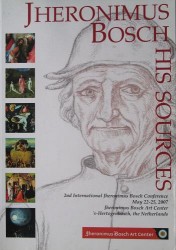
Fischer 2010
“Jheronimus Bosch’s Works of Art as allegorical and grotesque Moral Satire – theological, pastoral and didactic Sources” (Stefan Fischer) 2010
[in: Eric De Bruyn and Jos Koldeweij (eds.), Jheronimus Bosch. His Sources. 2nd International Jheronimus Bosch Conference, May 22-25 2007, Jheronimus Bosch Art Center, ’s-Hertogenbosch, the Netherlands. Jheronimus Bosch Art Center, ’s-Hertogenbosch, 2010, pp. 145-156]
In this contribution Fischer suggests that the homiletic tradition of the mendicant orders and of the Christian reformist movements was important for the concept of Bosch’s art. Especially the Dominicans were closely connected with the Brotherhood of Our Lady in ’s-Hertogenbosch. Hans-Joachim Raupp has shown that moralising and entertaining intentions are two sides of the same coin in the concept of moral satire, which has comic and more or less grotesque traits. He also showed that this concept was prevalent in fifteenth- and sixteenth-century literature and art. Siguenza, the Spanish advocate of Bosch’s art, applied the concept of comic grotesque moral satire to the painter, and compared Bosch with the controversial monk-poet Merlin Coccaio, alias Teofilio Folengo. Moral satire can be traced back to medieval poetic parodies and homiletics. Especially the mendicant orders like the Franciscans used anecdotic exempla in their preaching to reach a broader public. Randall has shown that drolleries are the visual counterparts to exempla. The choir stalls of Sint-Jan (St. John’s) in ’s-Hertogenbosch also have a number of drolleries. The use of hybrids and monstrous creations is one of the most remarkable elements in Bosch’s art. Although the principle of creating hybrids was common, Bosch dared to use them in panel paintings on a larger scale. An example is the hybrid devil trying to steal an ink pot on Bosch’s Saint John on Patmos.
The second element of moral satire is the use of contrasts, even of contrasting inversions or parodies. In Bosch’s Saint Jerome in Venice the inner struggle against lust is illustrated by a man who wants to ride a unicorn, which is the privilege of a virgin. Parody is frequently applied by Bosch. His Garden of Delights provides an example of a parody that is hard to uncover. The third basic principle of Bosch’s art is accumulation: a selection of examples under one topic. Bosch applied this principle in his Saint Christopher, in the Temptations of St. Anthony triptych, in the Haywain, the Garden of Delights and the Vienna Last Judgment.
The Cure of Folly is Bosch’s only painting without holy persons and thus a profane moral satire. All other works by Bosch can be regarded more or less as religious moral satires.
[explicit 24th February 2012]